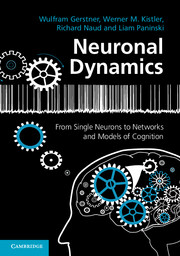Book contents
- Frontmatter
- Contents
- Preface
- PART ONE FOUNDATIONS OF NEURONAL DYNAMICS
- PART TWO GENERALIZED INTEGRATE-AND-FIRE NEURONS
- PART THREE NETWORKS OF NEURONS AND POPULATION ACTIVITY
- PART FOUR DYNAMICS OF COGNITION
- 16 Competing populations and decision making
- 17 Memory and attractor dynamics
- 18 Cortical field models for perception
- 19 Synaptic plasticity and learning
- 20 Outlook: dynamics in plastic networks
- References
- Index
20 - Outlook: dynamics in plastic networks
Published online by Cambridge University Press: 05 August 2014
- Frontmatter
- Contents
- Preface
- PART ONE FOUNDATIONS OF NEURONAL DYNAMICS
- PART TWO GENERALIZED INTEGRATE-AND-FIRE NEURONS
- PART THREE NETWORKS OF NEURONS AND POPULATION ACTIVITY
- PART FOUR DYNAMICS OF COGNITION
- 16 Competing populations and decision making
- 17 Memory and attractor dynamics
- 18 Cortical field models for perception
- 19 Synaptic plasticity and learning
- 20 Outlook: dynamics in plastic networks
- References
- Index
Summary
In this final chapter, we combine the dynamics of single neurons (Parts I and II) and networks (Part III) with synaptic plasticity (Chapter 19) and illustrate their interaction in a few applications.
In Section 20.1 on “reservoir computing” we show that the network dynamics in random networks of excitatory and inhibitory neurons is sufficiently rich to serve as a computing device that buffers past inputs and computes on present ones. In Section 20.2 we study oscillations that arise in networks of spiking neurons and outline how synaptic plasticity interacts with oscillations. Finally, in Section 20.3, we illustrate why the study of neuronal dynamics is not just an intellectual exercise, but might, one day, become useful for applications or, eventually, benefit human patients.
Reservoir computing
One of the reasons the dynamics of neuronal networks are rich is that networks have a nontrivial connectivity structure linking different neuron types in an intricate interaction pattern. Moreover, network dynamics are rich because they span many time scales. The fastest time scale is set by the duration of an action potential, i.e., a few milliseconds. Synaptic facilitation and depression (Chapter 3) or adaptation (Chapter 6) occur on time scales from a few hundred milliseconds to seconds. Finally, long-lasting changes of synapses can be induced in a few seconds, but last from hours to days (Chapter 19).
- Type
- Chapter
- Information
- Neuronal DynamicsFrom Single Neurons to Networks and Models of Cognition, pp. 524 - 546Publisher: Cambridge University PressPrint publication year: 2014

